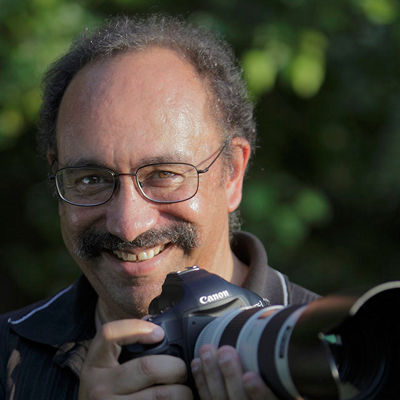If you are using a digital SLR camera in 2025, another reason to consider converting over to mirrorless is image quality from improvements in lenses. It’s a fact: most mirrorless lenses, especially wide-angle and normal focal lengths, are improved in comparison to their previous counterparts for digital SLRs. We’ll explain why this is often the case, in this article.
Many Mirrorless Lenses are Simply Sharper
The passage of time, alone, has brought new refinements as well as technology advancements to lenses, as it has for many mass-produced products. A careful look at the Canon RF (and RF-S) lens lines will show that.
You can’t see it in this technical graphic of the RF50mm F1.2 L USM lens, but lenses like this benefit from both simply more modern optical advancements, and especially from the benefits of the overall mirrorless structure — as we’ll explain in this article. The bottom line: the RF version of the 50mm f/1.2 L-series lens, by any measure, is noticeably clearer optically than its previous EF-mount counterpart for SLRs.
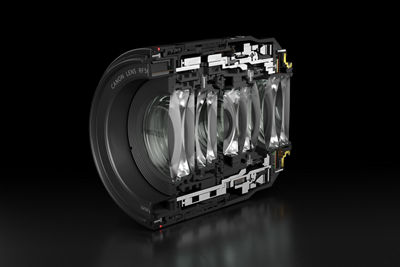
But beyond technological progress, mirrorless lenses truly are different from those in digital SLRs. At the heart of this is what Canon engineers refer to as the “mirrorless structure,” relating to the fundamental design of camera bodies and lenses. It’s here that you need to look first, to consider why mirrorless cameras put even greater optical performance in your hands than you can get (in many cases) with digital SLRs.
Understanding the Foundation: The “Mirrorless Structure”
Many optical engineers and designers have been clear for years: interchangeable lenses can perform better, with improved sharpness, detail and contrast (vs. traditional DSLR designs), if the following two design elements can be combined:
- Wide lens mount diameter
- Lens mount positioned closer to the image sensor (mount to sensor distances: EOS DSLRs — 44.00mm; EOS R-series mirrorless — 20.00mm)
Here’s the key to understanding why wide-angle and normal focal length lenses for mirrorless can deliver superior quality to their DSLR counterparts. In this cut-away graphic, showing the original EOS R camera with the RF24-105mm F4 L IS USM lens, a yellow arrow highlights the CMOS image sensor. If the rear optical section of the lens — highlighted in green — can maintain a large overall diameter AND be closer to the sensor, the front section of the lens (in red) can be made smaller in overall diameter. And with reduced size of the front section, light entering the lens, especially toward its outer areas, requires less refraction or “bending” as it travels toward the image sensor.

Here’s why: a large mount diameter effectively means the glass in the rear section of the lens can likewise be greater in overall diameter. If that’s combined with the mount being closer to the image sensor, important optical changes can occur toward the front of a given lens design:
- Potentially Smaller Front Section of the Lens
This can of course mean the potential for smaller and lighter lenses. But more importantly, if the front section is smaller, the optics toward the front of the lens don’t have to bend, or refract, the incoming light as strongly. Any time the path of light is bent by glass elements within a lens (especially light at the outer areas of the lens), there’s the potential for aberrations, optical imperfections and reductions in overall sharpness and optical performance. The more light is refracted, the greater this risk becomes. - Amazing Optical Performance in Many Wide-angle Mirrorless Designs
By using a larger rear optical section, and moving it closer to the image sensor, there’s tremendous potential to improve image quality in a design engineered for mirrorless. Incoming light simply can travel a straighter path to the sensor, with less bending. And that directly means lower potential for image-degrading aberrations within the lens.
We especially see this in wide-angle designs, as well as fast-aperture normal focal length designs. Admittedly, the effect here isn’t as great as we look at telephoto designs. But in wide-angle lenses, the impact is significant — and it means mirrorless can put a better lens in your camera bag than most comparable DSLR wide-angle lenses.
Wide-angle shooters really reap the benefits of switching to mirrorless cameras and lenses. Edge-to-edge sharpness, always a challenge in wide- and especially ultra wide-angle designs, is a hallmark of modern mirrorless lenses. Here, the incredible RF10-20mm F4 L IS STM is used in a highly detailed landscape shot. But it’s not just high-end, L-series lenses that benefit… even less-expensive, compact RF and RF-S wide- and ultra wide-angle lenses show quality gains, compared to earlier SLR lens designs.
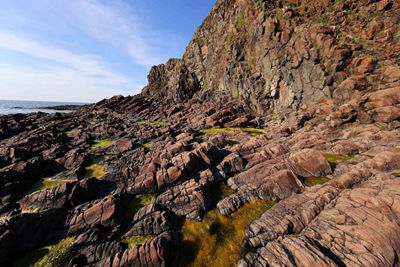
- Smaller, Lighter Lens Designs
Another by-product of combining a wide lens mount (and rear optical section of the lens) and placing it closer to the sensor is the potential for reduced size and weight in some lenses. We especially see this with some fast-aperture lenses (such as the Canon RF24mm F1.4 L VCM, for example), and in ultra wide-angle designs (the RF10-20mm F4 L IS STM is another example, radically smaller and lighter than the previous Canon EF11-24mm f/4L USM design). The mirrorless structure, as applied here, contributes to a noticeable reduction in the diameter and weight of the front section of some wide- and ultra wide-angle designs.
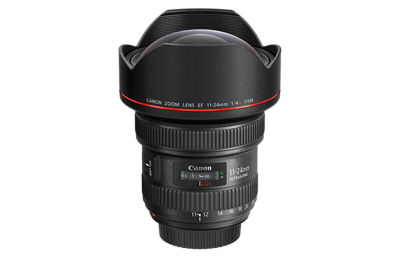
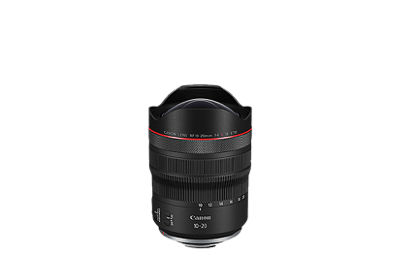
A perfect example of how mirrorless design contributes to smaller and yet, often, better lenses is a side-by-side of the EF 11-24mm f/4L lens (for SLR cameras) and its mirrorless counterpart, the remarkable RF10-20mm f/4L IS lens. It’s not your imagination — the front section of the RF lens is vastly smaller in diameter, and weight, vs. the previous EF ultra-wide zoom lens.
- Potential for improved image quality with fewer optical elements*
We already mentioned, especially in wide-angle and fast-aperture designs, how the mirrorless structure can inherently improve optical performance for critical users. But another by-product is that if the lens has fewer inherent optical imperfections or aberrations, there’s less need for added lens elements further toward the rear of the lens, to specifically correct aberrations from the front section of the lens. Again, this can mean improved performance in lenses that are potentially lighter and optically superior to comparable DSLR lenses.
* Each piece of glass or optical material in a lens is called an “element.”
The RF35mm F1.8 IS STM showcases several important aspects of modern mirrorless lens design. Its optical construction shows both a somewhat simplified rear optical section, and in particular, a much smaller front section (left side of the lens, in this cut-away graphic) — it’s easy to see the large rear section, toward the right side, in this comparison. Another cool feature in this lens: it offers close-focusing to half life-size, or 0.5x magnification, something not possible in previous Canon EF 35mm lenses for full-frame cameras.
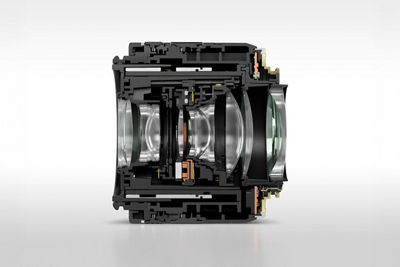
- Outstanding Sharpness and Optical Performance, if Size and Weight Aren’t Reduced
Obviously, not every Canon RF-mount lens is smaller and lighter than a comparable EF-mount lens from the DSLR era. Another design choice lens engineers have, with mirrorless, is to allow for large physical size, but to provide significant and thorough improvements in optical quality. An example might be the Canon RF24-70mm F2.8 L IS USM lens, which is nearly the same size as the older EF-mount design, but even better throughout its zoom range in optical performance. Again, the inherent advantages of the mirrorless structure — keeping a wide rear section, and moving it closer to the sensor — bring quality advantages.
Another example is the RF50mm F1.2 L USM lens, compared to the previous EF50mm f/1.2L USM design. There’s absolutely no question: the optical performance of the (admittedly larger and heavier) RF-mount lens is demonstrably superior to the EF lens, in essentially any situation.
Designed for full-frame mirrorless cameras, the RF50mm F1.2 L USM lens is larger than its EF-series predecessor, but clearer optically in virtually all aspects. Here, it’s being used wide-open at f/1.2, with the camera’s Eye Detect AF putting focus on the subject’s eye.

New Lens Designs, Made Possible by Mirrorless
Even if you’re not in the immediate market for very advanced, high-end lenses, you should be aware that it’s the switch to the mirrorless design that has allowed Canon engineers to develop some entirely new designs, never possible with traditional DSLR lens design.
One example is the RF28-70mm F2 L USM, a constant-aperture, f/2.0 zoom lens with superb image quality. Some advanced photographers who shoot weddings, events, and even commercial work in low-light environments had clamored for years to develop a “standard” zoom lens with a maximum aperture wider than f/2.8. In 2018, as Canon introduced the full-frame mirrorless EOS R system, the launch of the RF28-70mm F2 showcased what is optically possible with mirrorless — and underscored Canon engineers’ claim that the entire EOS R system was indeed a “lens-first” system.
Another, more recent “first” for full-frame cameras is Canon’s RF24-105mm F2.8 L IS USM Z, a constant-aperture, f/2.8 wide-to-tele zoom lens. Again, the idea of a constant-aperture, f/2.8 24-105mm lens has been floated by photographers from all camera brands for years — Canon’s engineering excellence and the possibilities with the mirrorless RF lens mount made it possible.
Mirrorless design has made possible a lens that, for decades, has been on photographers’ wish lists — a 24-105mm with a constant f/2.8 maximum aperture. An industry first, the RF24-105mm F2.8 L IS USM Z is a professional-level problem solver in many situations, and outstanding for both video and still-image shooting.

In both these cases, Canon’s optical designers have explained that with the previous DSLR lens mount structure, such lenses were a practical impossibility — their front sections would have been enormous (and heavy!), and their optical performance significantly compromised as well. Now, because of the foundation of the mirrorless structure we’ve explained in this article, these lenses are available to Canon EOS R-system users, and along with wide and constant maximum apertures, they provide stunning image quality.
Summary
Digital SLRs and their lenses have served photographers well, and for a long time. But there’s little question that if you’re a critical video or still-image shooter, you need to consider the various advantages that modern mirrorless models place in the user’s hands. Lenses are a key aspect of this. Along with the technical advancements that inevitably occur with the passage of time, the transition to a mirrorless design — as we’ve explained here — has brought about a corresponding transition in image quality that the critical user can and will see. There’s no way to sugar-coat it: in general, you’ll have the potential for sharper, more contrasty images and video if you make the switch to mirrorless. No one’s saying DLSR gear is bad, but we are saying there’s a clear-cut way to step forward. It’s mirrorless.



